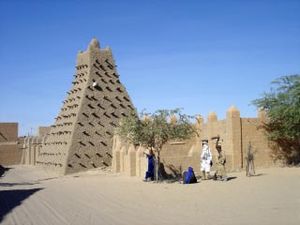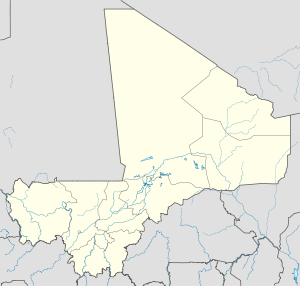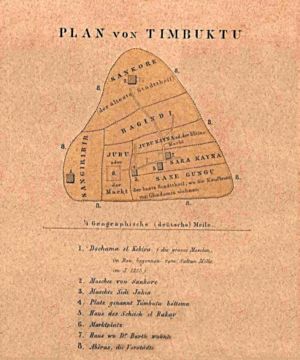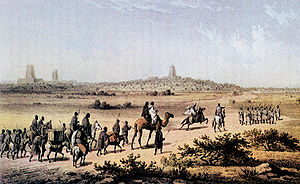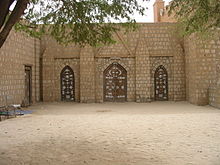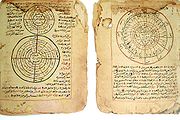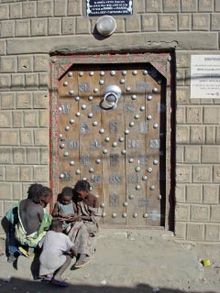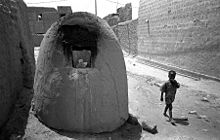
Timbuktu
Background to the schools Wikipedia
This Wikipedia selection is available offline from SOS Children for distribution in the developing world. Visit the SOS Children website at http://www.soschildren.org/
| Timbuktu Tumbutu |
|
|---|---|
| — City — | |
| transcription(s) | |
| • Koyra Chiini: | Tumbutu |
| Sankore Mosque in Timbuktu | |
|
|
|
| Coordinates: 16°46′33″N 3°00′34″W Coordinates: 16°46′33″N 3°00′34″W | |
| Country | |
| Region | Tombouctou Region |
| Cercle | Timbuktu Cercle |
| Settled | 10th century |
| Elevation | 261 m (856 ft) |
| Population (1998) | |
| • Total | 31,973 |
Timbuktu (Timbuctoo) ( Koyra Chiini: Tumbutu; French: Tombouctou) is a city in Tombouctou Region, in the West African nation of Mali. It was made prosperous by the tenth mansa of the Mali Empire, Mansa Musa. It is home to Sankore University and other madrasas, and was an intellectual and spiritual capital and centre for the propagation of Islam throughout Africa in the 15th and 16th centuries. Its three great mosques, Djingareyber, Sankore and Sidi Yahya, recall Timbuktu's golden age. Although continuously restored, these monuments are today under threat from desertification.
Populated by Songhay, Tuareg, Fulani, and Mandé people, Timbuktu is about 15 km north of the Niger River. It is also at the intersection of an east–west and a north–south Trans-Saharan trade route across the Sahara to Araouane. It was important historically (and still is today) as an entrepot for rock-salt originally from Taghaza, now from Taoudenni.
Its geographical setting made it a natural meeting point for nearby west African populations and nomadic Berber and Arab peoples from the north. Its long history as a trading outpost that linked west Africa with Berber, Arab, and Jewish traders throughout north Africa, and thereby indirectly with traders from Europe, has given it a fabled status, and in the West it was for long a metaphor for exotic, distant lands: "from here to Timbuktu."
Timbuktu's long-lasting contribution to Islamic and world civilization is scholarship. Timbuktu is assumed to have had one of the first universities in the world. Local scholars and collectors still boast an impressive collection of ancient Greek texts from that era. By the 14th century, important books were written and copied in Timbuktu, establishing the city as the centre of a significant written tradition in Africa.
History
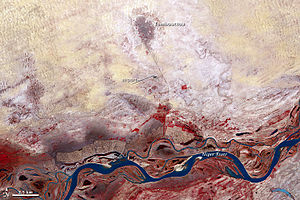
Origins
Timbuktu was established by the nomadic Tuareg as early as the 10th century. Although Tuaregs founded Timbuktu, it was only as a seasonal settlement. Roaming the desert during the wet months, in summer they stayed near the flood plains of the Inner Niger Delta. Since the terrain directly at the water wasn’t suitable due to mosquitoes, a well was dug a few miles from the river.
Permanent Settlements
In the eleventh century merchants from Djenne set up the various markets and built permanent dwellings in the town, establishing the site as a meeting place for people traveling by camel. They also introduced the Islam and reading, through the Qur'an. Before Islam, the population worshiped Ouagadou-Bida, a mythical water-serpent of the Niger River. With the rise of the Ghana Empire, several Trans Saharan trade routes had been established. Salt from Mediterranean Africa was traded with West-African gold and ivory, and large numbers of slaves. Halfway through the eleventh century, however, new goldmines near Bure made for an eastward shift of the trade routes. This development made Timbuktu a prosperous city where goods from camels were loaded on boats on the Niger.
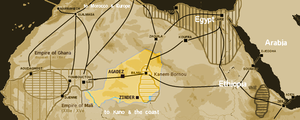
Rise of the Mali Empire
During the twelfth century, the remnants of the Ghana Empire were invaded by the Sosso Empire king Soumaoro Kanté. Muslim scholars from Walata (beginning to replace Aoudaghost as trade route terminus) fled to Timbuktu and solidified the position of the Islam. Timbuktu had become a centre of Islamic learning, with its Sankore University and 180 Quranic schools. In 1324 Timbuktu was peacefully annexed by king Musa I, returning from his pilgrimage to Mecca. The city now part of the Mali Empire, king Musa I ordered the construction of a royal palace and, together with his following of hundreds of Muslim scholars, built the learning centre of Djingarey Ber in 1327.
By 1375, Timbuktu appeared in the Catalan Atlas, showing that it was, by then, a commercial centre linked to the North-African cities and had caught Europe's eye.
Tuareg Rule & the Songhayan Empire
With the power of the Mali Empire waning in the first half of the 14th century, Maghsharan Tuareg took control of the city in 1433-1434 and installed a Sanhaja governor. Thirty years later however, the rising Songhay Empire expanded, absorbing Timbuktu in 1468-1469. Lead by consecutively Sunni Ali Ber (1468–1492), Sunni Baru (1492–1493) and Askia Mohammad I (1493–1528), who brought the Songhay Empire and Timbuktu a golden age. With the capital of the empire being Gao, Timbuktu enjoyed a relatively autonomous position. Merchants from Ghadames, Awjidah, and numerous other cities of North Africa gathered there to buy gold and slaves in exchange for the Saharan salt of Taghaza and for North African cloth and horses. Leadership of the Empire stayed in the Askia dynasty until 1591, although internal fights led to a decline of prosperity in the city.
Moroccan Occupation
The city's capture on August 17, 1591 by an army sent by the Saadi ruler of Morocco, Ahmad I al-Mansur, and led by pasha Mahmud B. Zarqun in search of gold mines, brought the end of an era of relative autonomy. Intellectually, and to a large extent economically, Timbuktu now entered a long period of decline. In 1593, Saadi cited 'disloyalty' as the reason for arresting, and subsequently killing or exiling many of Timbuktu's scholars, including Ahmad Baba. Perhaps the city's greatest scholar, he was forced to move to Marrakesh because of the intellectual oppostion to the city's Morrocan governor, where he continued to generate attention of the scholarly world. Ahmad Baba later returned to Timbuktu, where he died in 1608. The ultimate decline continued, with the increasing trans-atlantic traderoutes (transporting African slaves, including leaders and scholars of Timbuktu) marginalising Timbuktu's role. While initially controlling the Morocco - Timbuktu traderoutes, the grip of the Moroccans on the city began losing its strength in the period until 1780, and in the early 19th century the Empire didn't succeed in protecting the city against invasions and the subsequent short occupations of the Tuareg (1800), Fula (1813) and Tukular 1840. It is uncertain whether the Tukular were still in control, or if the Tuaregs had once again regained power, when the French arrived.
Discovery by the West
Historic descriptions of the city had been around since Leo Africanus' account in the first half of the 16th century, and they prompted several European individuals and organizations to make great efforts to discover Timbuktu and its fabled riches. In 1788 a group of titled Englishmen formed the African Association with the goal of finding the city and charting the course of the Niger River. The earliest of their sponsored explorers was a young Scottish adventurer named Mungo Park, who made two trips in search of the Niger River and Timbuktu (departing first in 1795 and then in 1805). It is believed that Park was the first Westerner to have reached the city, but he died in modern day Nigeria without having the chance to report his findings. In 1824, the Paris-based Société de Géographie offered a 10,000 franc prize to the first non- Muslim to reach the town and return with information about it. The Briton Gordon Laing arrived in September 1826 but was killed shortly after by local Muslims who were fearful of European discovery and intervention. The Frenchman René Caillié arrived in 1828 traveling alone disguised as a Muslim; he was able to safely return and claim the prize.
Robert Adams, an African-American sailor, claimed to have visited the city in 1811 as a slave after his ship wrecked off the African coast. He later gave an account to the British consul in Tangier, Morocco in 1813. He published his account in an 1816 book, The Narrative of Robert Adams, a Barbary Captive (still in print as of 2006), but doubts remain about his account. Three other Europeans reached the city before 1890: Heinrich Barth in 1853 and the German Oskar Lenz with the Spaniard Cristobal Benítez in 1880.
Part of the French Colonial Empire
After the scramble for Africa had been formalized in the Berlin Conference, land between the 14th meridian and Miltou, Chad would become French territory, bound in the south by a line running from Say, Niger to Baroua. Although the Timbuktu region was now French in name, the principle of effectivity needed France to actually hold power in those areas assigned, e.g. by signing agreements with local chiefs, setting up a government and making use of the area economically, before the claim would be definitive. On December 28, 1893, the city, by then in a state of poverty, was annexed by a small group of French, lead by lieutenant Boiteux: Timbuktu was now part of French Sudan, a colony of France. This situation lasted until 1902: after dividing part of the colony back in 1899, the remaining areas were now reorganized and, for a brief period, called Senegambia and Niger. Only two years later, in 1904, another reorganization followed and Timbuktu became part of Upper Senegal and Niger until, in 1920, the colony assumed its old name of French Sudan once again.
World War II
During World War II, several legions were recruited in French Soudan, with some coming from Timbuktu, to help general Charles de Gaulle fight Nazi-occupied France and southern Vichy France.
About 60 British merchant seamen from the SS Allende (Cardiff), sunk on the 17th March 1942 off the South coast of West Africa, were held prisoner in the city during the Second World War. Two months later, after having been transported from Freetown to Timbuktu, two of them, AB John Turnbull Graham (2 May 1942, age 23) and Chief Engineer William Soutter (28 May 1942, age 60) died there in May 1942. Both men were buried in the European cemetery - possibly the most remote British war graves tended by the Commonwealth War Graves Commission.
Independency & Onwards
After World War II had come to an end, the French government under Charles de Gaulle granted the colony more and more freedom. After a period as part of the short-lived Mali Federation, The Republic of Mali was proclaimed on September 22, 1960. After a November 19, 1968, a new constitution was created in 1974, making Mali a single-party state. By then, the canal linking the city with the Niger River had already been filled with sand from the encroaching desert. Severe droughts hit the Sahel region in 1973 and 1985, decimating the Tuareg population around Timbuktu who relied on goat herding. The Niger's waterlevel dropped, postponing the arrivel of foodtransport and tradingvessels. The crisis drove many of the inhabitants of Tombouctou Region to Algeria and Libya. Those who stayed relied on humanitarion organisations such as UNICEF for food and water.
Etymology
According to a popular etymology, its name is made up of: tin (pronounced "tain") which means "well" and Buktu, the name of an old Malian woman known for her honesty and who once upon a time lived in the region. Tuareg and other travelers would entrust this woman with any belongings for which they had no use on their return trip to the north. Thus, when a Tuareg, upon returning to his home, was asked where he had left his belongings, he would answer: "I left them at Tin Buktu", meaning Buktu's well. The two terms ended up fusing into one word, thus giving the city the name ofTinbuktu which later became Timbuktu. However, the French orientalist René Basset forwarded a more plausible etymology: in the Berber languages "buqt" means "far away", so "Tin-Buqt(u)" means a place almost at the other end of the world, i.e. the Sahara.
Legendary tales
Tales of Timbuktu's fabulous wealth helped prompt European exploration of the west coast of Africa. Among the earliest descriptions of Timbuktu are those of Leo Africanus, Ibn Battuta, and Shabeni.
Leo Africanus
Perhaps most famous among the accounts written about Timbuktu is that by Leo Africanus. Born al-Hasan ibn Muhammad ibn Ahmad al-Wazzan, Leo Africanus was an ambassador serving the Sultan of Fez when, in 1518 he was captured by Christian pirates and delivered to the Pope in Rome. There he converted from Islam to Christianity and wrote a book on Africa. Describing Timbuktu when the Songhai empire was at its height, the English edition of his book includes the description:
The rich king of Tombuto hath many plates and scepters of gold, some whereof weigh 1300 pounds. ... He hath always 3000 horsemen ... (and) a great store of doctors, judges, priests, and other learned men, that are bountifully maintained at the king's cost and charges.
According to Leo Africanus, there were abundant supplies of locally produced corn, cattle, milk and butter, though there were neither gardens nor orchards surrounding the city.
Shabeni
Shabeni was a merchant from Tetouan, Morocco who was captured and ended up in England where he told his story of how as a child of 14, around 1787, he had gone with his father to Timbuktu. A version of his story is related by James Grey Jackson in his book An Account of Timbuctoo and Hausa, 1820:
On the east side of the city of Timbuctoo, there is a large forest, in which are a great many elephants. The timber here is very large. The trees on the outside of the forest are remarkable...they are of such a size that the largest cannot be girded by two men. They bear a kind of berry about the size of a walnut, in clusters consisting of from ten to twenty berries. Shabeeny cannot say what is the extent of this forest, but it is very large.
Centre of learning
| Timbuktu | |
|---|---|
| Name as inscribed on the World Heritage List | |
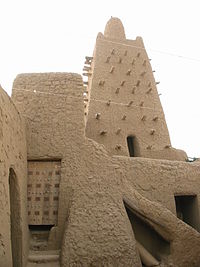 |
|
| Country | |
| Type | Cultural |
| Criteria | ii, iv, v |
| Reference | 119 |
| UNESCO region | Africa |
| Inscription history | |
| Inscription | 1988 (12th Session) |
| Endangered | 1990-2005 |
During the early 15th century, a number of Islamic institutions were erected. The most famous of these is the Sankore mosque, also known as the University of Sankore.
While Islam was practiced in the cities, the local rural majority were non-Muslim traditionalists. Often the leaders were nominal Muslims in the interest of economic advancement while the masses were traditionalists.
University of Sankore
Sankore, as it stands now, was built in 1581 AD (= 989 A. H.) on a much older site (probably from the 13th or 14th century) and became the centre of the Islamic scholarly community in Timbuktu. The "University of Sankore" was a madrassah, very different in organization from the universities of medieval Europe. It was composed of several entirely independent schools or colleges, each run by a single master or imam. Students associated themselves with a single teacher, and courses took place in the open courtyards of mosque complexes or private residences. The primary focus of these schools was the teaching of the Qur'an, although broader instruction in fields such as logic, astronomy, and history also took place. Scholars wrote their own books as part of a socioeconomic model based on scholarship. The profit made by buying and selling of books was only second to the gold-salt trade. Among the most formidable scholars, professors and lecturers was Ahmed Baba – a highly distinguished historian frequently quoted in the Tarikh al-Sudan and other works.
The manuscripts and libraries of Timbuktu
The most outstanding treasure at Timbuktu are the 100,000 manuscripts kept by the great families from the town.. These manuscripts, some of them dated from pre-Islamic times and 12th century, have been preserved as family secrets in the town and in other villages nearby. The majority were written in Arabic or Fulani, by wise men coming from the Mali Empire. Their contents are didactic, especially in the subjects of astronomy, music, and botany. More recent manuscripts deal with law, sciences and history (with the important 17th century chronicles, Tarikh al-fattash and Tarikh al-Sudan), religion, trade, etc.
The Ahmed Baba Institute (Cedrab), founded in 1970 by the government of Mali, with collaboration of Unesco, holds some of these manuscripts in order to restore and digitize them. More than 18,000 manuscripts have been collected by the Ahmed Baba centre, but there are an estimated 300,000-700,000 manuscripts in the region.
The collection of ancient manuscripts at the University of Sankore and other sites around Timbuktu document the magnificence of the institution, as well as the city itself, while enabling scholars to reconstruct the past in fairly intimate detail. Dating from the 16th to the 18th centuries, these manuscripts cover every aspect of human endeavor and are indicative of the high level of civilization attained by West Africans at the time. In testament to the glory of Timbuktu, for example, a West African Islamic proverb states that "Salt comes from the north, gold from the south, but the word of God and the treasures of wisdom come from Timbuktu."
From 60 to 80 private libraries in the town have been preserving these manuscripts: Mamma Haidara Library; Fondo Kati Library (with approximately 3,000 records from Andalusian origin, the oldest dated from 14th and 15th centuries); Al-Wangari Library; and Mohamed Tahar Library, among them. These libraries are considered part of the " African Ink Road" that stretched from West Africa connecting North Africa and East Africa. At one time there were 120 libraries with manuscripts in Timbuktu and surrounding areas. There are more than one million objects preserved in Mali with an additional 20 million in other parts of Africa, the largest concentration of which is in Sokoto, Nigeria, although the full extent of the manuscripts is unknown. During the colonial era efforts were made to conceal the documents after a number of entire libraries were taken to Paris, London and other parts of Europe. Some manuscripts were buried underground, while others were hidden in the desert or in caves. Many are still hidden today. The United States Library of Congress microfilmed a sampling of the manuscripts during an exhibition there in June 2003. In February 2006 a joint South African/Malian effort began investigating the Timbuktu manuscripts to assess the level of scientific knowledge in Timbuktu and in the other regions of West Africa.
Timbuktu today
Today, Timbuktu is an impoverished town, although its reputation makes it a tourist attraction to the point where it even has an international airport ( Timbuktu Airport). It is one of the eight regions of Mali, and is home to the region's local governor. It is the sister city to Djenné, also in Mali. The 1998 census listed its population at 31,973, up from 31,962 in the census of 1987.
Timbuktu is a UNESCO World Heritage Site, listed since 1988. In 1990, it was added to the list of World Heritage Sites in danger due to the threat of desert sands. A program was set up to preserve the site and, in 2005, it was taken off the list of endangered sites. However, new constructions are threatening the ancient mosques, a UNESCO Committee warns.
Timbuktu was one of the major stops during Henry Louis Gates' PBS special "Wonders of the African World". Gates visited with Abdel Kadir Haidara, curator of the Mamma Haidara Library together with Ali Ould Sidi from the Cultural Mission of Mali. It is thanks to Gates that an Andrew Mellon Foundation grant was obtained to finance the construction of the library's facilities, later inspiring the work of the Timbuktu Manuscripts Project. Unfortunately, no practising book artists exist in Timbuktu although cultural memory of book artisans is still alive, catering to the tourist trade. The town is home to an institute dedicated to preserving historic documents from the region, in addition to two small museums (one of them the house in which the great German explorer Heinrich Barth spent six months in 1853-54), and the symbolic Flame of Peace monument commemorating the reconciliation between the Tuareg and the government of Mali.
Attractions
Timbuktu's vernacular architecture is marked by mud mosques, which are said to have inspired Antoni Gaudí. These include
- Djinguereber Mosque, built in 1327 by El Saheli
- Sankore Mosque, also known as Sankore University, built in the early fifteenth century
- Sidi Yahya mosque, built in the 1441 by Mohamed Naddah.
Other attractions include a museum, terraced gardens and a water tower.
Language
The main language of Timbuktu is a Songhay language called Koyra Chiini, spoken by over 80% of residents. Smaller groups, numbering 10% each before many were expelled during the Tuareg/Arab rebellion of 1990-1994, speak Hassaniya Arabic and Tamashek.
Climate
The weather is hot and dry throughout much of the year with plenty of sunshine. Average daily maximum temperatures in the hottest months of the year - May and June - exceed 40°C. Temperatures are slightly cooler, though still very hot, from July through September, when practically all of the meager annual rainfall occurs. Only the winter months of December and January have average daily maximum temperatures below 32°C.
| Climate data for Timbuktu | |||||||||||||
|---|---|---|---|---|---|---|---|---|---|---|---|---|---|
| Month | Jan | Feb | Mar | Apr | May | Jun | Jul | Aug | Sep | Oct | Nov | Dec | Year |
| Source: World Meteorological Organization | |||||||||||||
Famous people connected with Timbuktu
- Cristina Nardone (1983-2008) Served as a Peace Corps Volunteer and Project Manager for AED who sacrificed her life to help others.
- Ali Farka Toure (1939–2006) Born in Kanau, in the Timbuktu region.
- Heinrich Barth (1821–1865) German traveller and scholar and one of the first Europeans to investigate African history
- Bernard Peter de Neumann, GM (1917–1972) "The Man From Timbuctoo". Held prisoner of war there along with other members of the crew of the Criton during 1941-1942.
- Ibn Battuta (1304–1368) made a famous journey to Timbuktu, along with many others throughout his lifetime.
- Mungo Park (1771-1806) was the first European to reach the Niger River. On his second journey down the river he passed by Timbuktu but was not able to make it to the city due to local aggression. He drowned in the Bussa rapids a few hundred miles further down river.
- Mardochée abi Serour (merchant), born circa 1930 in Aqqa (a Saharian oasis) traded merchandise between Mogador (presently Essaouira) and Timbuktu, and even owned a house in Timbuktu.
- René Caillié (1799-1838) was the first European to return alive from Timbuktu
In popular culture
The image of the city as mysterious or mythical has survived to the present day in other countries: a survey among 150 young Britons in 2006 found 34% did not believe the town existed, while the other 66% considered it "a mythical place".
This idea of mystique has long been a part of Western popular culture.
Donald Duck uses Timbuktu as a safe haven, and a Donald Duck comic subseries is situated in the city. In the 1970 Disney animated feature The Aristocats, Edgar the butler places the cats in a trunk which he plans to send to Timbuktu. It is mistakenly noted to be in French Equatorial Africa, instead of French West Africa.
Timbuktu also makes an appearance in the British musical Oliver when The Artful Dodger sings to Nancy, "I'd do anything for you, dear, anything, for you" to which Nancy sings in reply, "Paint your face bright blue?" "Anything", Dodger responds. "Go to Timbuktu?" Nancy asks. "And back again", Dodger responds, and the song continues.
